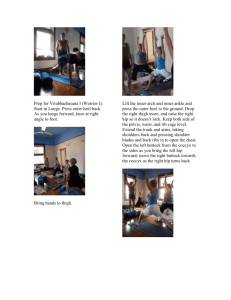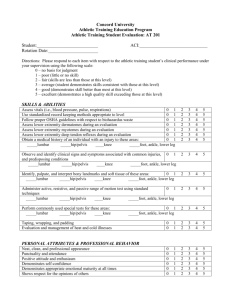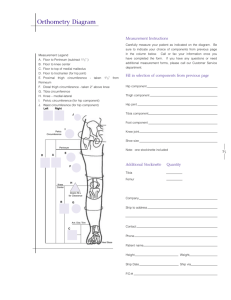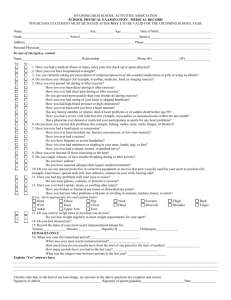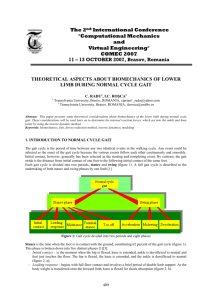Biomechanics Gait Analysis Homework: Kinematics & Kinetics
advertisement
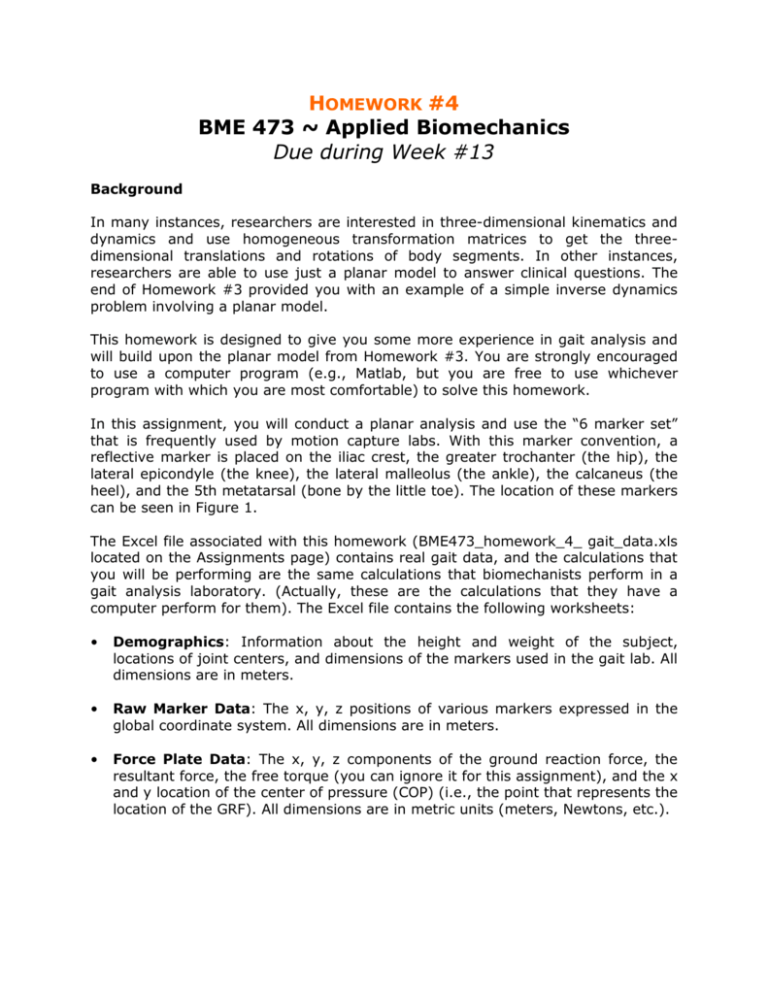
HOMEWORK #4 BME 473 ~ Applied Biomechanics Due during Week #13 Background In many instances, researchers are interested in three-dimensional kinematics and dynamics and use homogeneous transformation matrices to get the threedimensional translations and rotations of body segments. In other instances, researchers are able to use just a planar model to answer clinical questions. The end of Homework #3 provided you with an example of a simple inverse dynamics problem involving a planar model. This homework is designed to give you some more experience in gait analysis and will build upon the planar model from Homework #3. You are strongly encouraged to use a computer program (e.g., Matlab, but you are free to use whichever program with which you are most comfortable) to solve this homework. In this assignment, you will conduct a planar analysis and use the “6 marker set” that is frequently used by motion capture labs. With this marker convention, a reflective marker is placed on the iliac crest, the greater trochanter (the hip), the lateral epicondyle (the knee), the lateral malleolus (the ankle), the calcaneus (the heel), and the 5th metatarsal (bone by the little toe). The location of these markers can be seen in Figure 1. The Excel file associated with this homework (BME473_homework_4_ gait_data.xls located on the Assignments page) contains real gait data, and the calculations that you will be performing are the same calculations that biomechanists perform in a gait analysis laboratory. (Actually, these are the calculations that they have a computer perform for them). The Excel file contains the following worksheets: • Demographics: Information about the height and weight of the subject, locations of joint centers, and dimensions of the markers used in the gait lab. All dimensions are in meters. • Raw Marker Data: The x, y, z positions of various markers expressed in the global coordinate system. All dimensions are in meters. • Force Plate Data: The x, y, z components of the ground reaction force, the resultant force, the free torque (you can ignore it for this assignment), and the x and y location of the center of pressure (COP) (i.e., the point that represents the location of the GRF). All dimensions are in metric units (meters, Newtons, etc.). Figure 1: Marker Convention Kinematics 1. Please calculate and plot the hip, knee, and ankle flexion angles as a function of time. (Note that you have more than 1 gait cycle in the data file.) To do so, follow these steps: a. Get the joint center for the hip, knee, and ankle joints. To get joint centers from marker position, all you need to do is subtract off the values of the joint center correction factor (jcf) off of the x-coordinate of the hip, knee, or ankle marker. b. Establish the vectors that represent the HAT (head, arms, torso), thigh (femur), shank (tibia and fibula), and foot. Please have all vectors originating at the distal point and being directed proximally. (For example, the femur is defined by hip - knee). c. Normalize the vectors that represent the HAT, thigh, shank, and foot. d. Calculate the angle between the y-axis in the global coordinate system and vectors representing the HAT, femur, and tibia. (Figure 2). (Hint: use the dot product) e. Calculate the angle between the z-axis and vector representing the foot. f. Calculate the hip, knee, and ankle angles with the following formulas i. Hip angle = thigh angle - HAT angle ii. Knee angle = thigh angle - shank angle iii. Ankle angle = foot angle - shank angle g. Plot your results. 2. Label when heel strike and toe off occur on the three plots you just created. 3. Differentiate your angles for the foot, shank, thigh, and HAT to obtain the appropriate angular velocities and accelerations. Use the following formulas to conduct this numerical differentiation. The camera samples at 120 Hz. You don’t need to find the velocities and accelerations for the first and last data points. ( ) f (t f (t f ′′(t ) ≈ f ′ ti ≈ i − f (t i −1) 2∆t i −1) − 2f (t i ) + f (t i + 1 ) i + 1) ∆t 2 4. Numerically differentiate your knee and ankle position data to obtain the appropriate linear velocities and accelerations for these markers. You don’t need to find the velocities and accelerations for the first and last data points. Figure 2: Linkage Model Kinetics 5. The moment of inertia and center of mass of each segment is needed to perform inverse dynamic analysis. Anthropometric information from Winter (1990) can be used to calculate this information. Using the data in the table below, calculate the mass of the segment, the length of the segment, the position of the center of mass (COM) in the segment, and the moment of inertia about the center of mass for the foot, shank (tibia and fibula), thigh (femur), and HAT. Assume linear segments as shown in the figure. A B C Segment Segment mass/ total mass Segment length/ height D COM position from proximal end of segment /segment length Foot Shank Thigh HAT 0.0145 0.0465 0.1 0.678 0.055 0.246 0.245 0.47 0.5 0.433 0.433 0.626 E Radius of gyration about COM/ segment length 0.475 0.302 0.323 0.496 The height of the subject is 1.7526 m, and the mass of the subject is 66.7 kg. Columns B-D are fractions that should be scaled by total mass, height, or segment length as listed. Moment of inertia of a segment is defined as: I = mass * (radius _ of _ gyration) 2 Radius of gyration should be determined from the information given. 6. Please plot the vertical and horizontal ground reaction forces during the stance phase as a percentage of body weight. 7. Draw a free body diagram for the foot, shank, thigh, and HAT segments. You may ignore the mass and moment of inertia of the foot, as it is sometimes assumed that the mass of the foot is negligible when compared to the mass of shank. 8. Using homework 3 problem 4 as a primer, please derive the equations necessary to solve for the torques about the hip, knee, and ankle joints during the stance phase of gait for this model. Again, for simplicity, you may ignore the mass of the foot. Some things to consider: a. The location of the origin of the coordinate system for this problem is different than the location of the coordinate system in homework 3. Therefore, you are measuring positions, velocities, and accelerations with respect to a fixed laboratory reference frame. Think about how this changes your equations from the ones you had in homework 3. b. You have markers at the hip, knee, and ankle joints. Think about how you can use this information to simplify your equations from those used in homework 3. 9. For the given data, please use the equations you just derived in problem 8 to calculate the torques for the hip, knee, and ankle joints during the stance phase of gait. (Note: when solving the equations, remember that all angular velocities and accelerations need to be in radians).Plot your results and normalize them with respect to body mass (i.e., units are Nm/kg). Discussion 10.You used anthropometric data to determine the lengths of the segments in this assignment. Suppose Ted (of homework 2 fame) wants to work with you and suggests that you could just use motion data to determine segment length. Ted says that the magnitude of the distance between any 2 markers in the 6-marker convention could give you the appropriate segment length. To test Ted’s idea, plot the magnitude of the vector between the hip and knee for all of the time points in this study. Comment on the behavior of the curve you just plotted and compare this magnitude to the length of the thigh determined in problem 5. Comment on some possible explanations for the observed differences. 11.In problem 9, you were asked to normalize the joint torques by body mass. Why is it important to perform this normalization instead of just reporting a raw value in Newton-meters? 12.Which joint moment has the greatest magnitude (hip, knee, or ankle)? Could you suggest an explanation as to why this is the case? 13.Look at the shapes of the curves for the hip and knee torques in early stance. Please suggest a few explanations for what you observe and propose some possible solutions to correct the problem. (Hints: consider your results for problems 6 and 10. Also, what type of marker and force plate data are you working with?). Feedback How long did it take for you to complete this assignment? I am constantly changing and updating assignments, so this information is useful to me.


